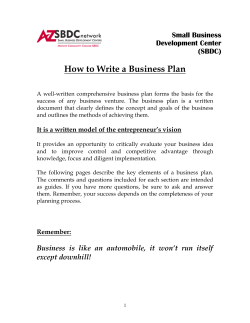
Energy Efficiency Financing Presented by: Paul Schueller, Franklin Energy Services
Energy Efficiency Financing Presented by: Paul Schueller, Franklin Energy Services Nels Andersen, Franklin Energy Services Presentation Outline: • Audience survey • How does financing factor into your energy efficiency projects? • Barriers to energy efficiency projects • Where does financing fit within energy efficiency project implementation? • Sources of financing • Financing tools Top Financial Barriers to Pursuing Energy Efficiency Insufficient internal capital budget Competition for other capital investments Appropriate financing options available No Goal Difficulty obtaining external financing at attractive rates and terms Goal Balance sheet debt limitations Inability to secure external financing 0% 5% 10% 15% 20% 25% 30% 35% Organizations with public goals and external financing implemented 84% more measures and are 2.7 times more likely to increase investments next year than organizations with neither Source: Energy Efficiency Indicator, 2013 Global Results - Institute for Building Efficiency Energy Efficiency Project Process Flow Energy Efficiency Measure Identification Estimation of Energy Savings Economic Evaluation of Costs/Benefits • Awareness of available technologies • Facility assessment • Engineering parameters • Calculations of energy use, pre and post • Project cash flows, pre and post • Cost of capital, discount rate Identification of Funding Source • Capital budget vs. O&M budget • Financing • Incentives • Alternatives: • Performance contracting, etc. Implementation • Project development • Coordination with operations • Installation Common Financing Options • • • • Bank Financing Energy Savings Performance Contracting Energy Service Agreements Power Purchase Agreements Bank Financing • • • • Project treated as any other type of capital investment Loan terms are based on credit worthiness Relatively simple transaction Project size and complexity will determine which bank type (local, regional, national) is most suited for a particular project Advantages Disadvantages • • • • • Lack of familiarity with energy efficiency projects and their characteristics • Cash flow from savings typically not included • Ability to secure financing solely dependent on credit score • On balance sheet transaction Typically lowest transaction costs Can leverage existing relationships Easiest contract structures Easily combined with incentive programs Paid-From-Savings Energy Efficiency Project Financing Energy, O&M Costs Avoided costs due to energy price increases Pre – Project Energy Costs Savings Used to Pay for Retrofit Measures Savings Post-Project Energy Costs Financing Term (years) Time Energy Savings Performance Contracting (ESPC) • • • • • Savings exceeds payments over the term of the contract, i.e. pay from savings Usually administered by Energy Service Companies (ESCO) Typically have long paybacks Most prevalent with federal and municipal buildings (MUSH market) Building owners with strong credit or access to low cost debt commonly prefer to self-finance • Examples of companies that provide ESPCs: • ESCOs – Johnson Controls, Burns & McDonnell, Honeywell, Siemens (https://www.naesco.org/organizations/companies.aspx?MemberTypeID=3) • Financiers – Bostonia Group, Catalyst Financial, Hannon Armstrong Advantages Disadvantages • • • • • • • • • Reduces project risk Enables financing of comprehensive projects Standard contracts and approaches Easily combined with incentive programs Relies on measurement and verification Significant negotiation and documentation Substantial transaction costs Dependent on credit worthiness Difficult to finance smaller projects (<$500,000). Energy Service Agreements (ESA) • Third party entities negotiate ESAs, arrange/provide capital, develop projects and manage installed equipment for large industrial and commercial projects • A Special Purpose Entity (SPE) typically finances the cost of the efficiency improvements, owns the equipment, and returns cash flows to the investors • The SPE owns all tax incentives, carbon credits, and government grants or rebates • Fixed payment is based on a cost per avoided energy basis, e.g. $/kWh. • Examples of companies that provide ESAs: • Metrus Energy, Catalyst Financial, Green City Finance, Clean Feet Investors, SCIenergy Advantages • Transactions are off-balance sheet • Projects can be initiated with no up-front cost • Due to the SPE structure, risk is limited to each individual deal • Relies on measurement and verification Disadvantages • • • • Significant negotiation and documentation Substantial transaction costs Difficult to finance smaller projects (<$500,000) New FASB rules on off-balance sheet projects might limit the model Power Purchase Agreements (PPA) • A contract between a power provider and a customer • Typically used for renewable energy and co-generation projects • Equipment is owned by the producer and sited on the customers property • The customer contracts to purchase the power produced over a set number of years • Fixed payment is based on a cost per avoided energy basis, e.g. $/kWh • Examples of companies that provide PPAs: • Catalyst Financial, CitiGreen, Sunpower Advantages Disadvantages • Costs established from the beginning and fixed for the duration of the contract • No up-front cost to the buyer to install the equipment • The provider provides the necessary capital • Provider assumes responsibility for equipment operations and maintenance costs • Expected volume of electricity produced is stipulated, with various, predetermined, results for generation above and below agreed upon levels • Usually some combination of tax credits, rebates and carbon credits are used to improve the investment profile of the renewable installation • Buyer does not obtain the benefits of ownership of the asset • Arrangement results in a long-term lease on the property • Long contract terms • Total project cost typically more expensive than bank financing Department of Energy Financing and Support Programs • Office of Energy Efficiency and Renewable Energy (EERE) financing portal: • https://www1.eere.energy.gov/financing/ • EERE Loan Guarantee Program: • http://www.lgprogram.energy.gov/ • Mostly involve alternative generation, transmission, and vehicles and advanced fuel processing • Solicitations for Business, Industry, and Universities • https://www1.eere.energy.gov/financing/business.html • Typically solicit advanced manufacturing and demonstration projects that reduce energy • Better Buildings, Better Plants Program • http://www1.eere.energy.gov/manufacturing/tech_assistance/betterplants/ • Not a funding source, provides technical assistance and national recognition Additional Resources • Cash Flow Opportunity Calculator: • http://www.energystar.gov/buildings/facility-owners-andmanagers/existing-buildings/find-financing/calculate-returns-energyefficiency • Energy Efficiency Financing – Models and Strategies: • http://www.cleanenergyfinancecenter.org/wp-content/uploads/EEFinancing-Models-and-Strategies-Oct.-2011.pdf • Energy Star Buildings Upgrade Manual – Chapter 4, Financing: • http://www.energystar.gov/ia/business/EPA_BUM_CH4_Financing.pdf
© Copyright 2025





















